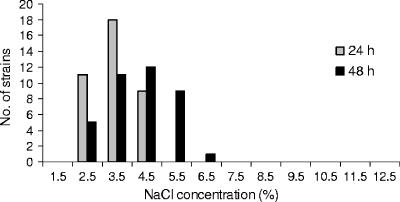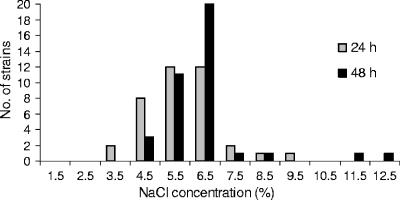The prevalence of methicillin-resistant Staphylococcus aureus (MRSA) strains causing nosocomial infections is still increasing worldwide, resulting in high morbidity and mortality rates and increased hospital costs (5, 6). So far, in hospitals in The Netherlands, a strict search-and-destroy policy, including screening for MRSA carriership by culturing, has kept the prevalence of MRSA under 1% (6, 8).
To increase the sensitivity of culturing methods, a mannitol salt enrichment broth is commonly used. This medium traditionally contains 7.5% sodium chloride as a selective agent based on the long-known high salt tolerance of staphylococci (1, 4). The Clinical Microbiology Procedures Handbook, published by the American Society for Microbiology, recommends using a broth with 6.5% or 7.5% NaCl (2).
In 1997, however, Jones et al. found that this salt enrichment broth inhibited the growth of the epidemic strain MRSA-16 (EMRSA-16) (3). They determined that the MIC of NaCl for EMRSA-16 was 7% and that low inocula of EMRSA-16 were inhibited by NaCl concentrations higher than 2.5%.
To optimize the MRSA screening protocol used in our laboratory, we determined the salt tolerance of a well-defined collection of 38 methicillin-resistant S. aureus strains (mecA gene positive with oxacillin MICs of 0.38 to ≥256 μg/ml and various phage types) and 45 methicillin-susceptible S. aureus (MSSA) strains (mecA gene negative with oxacillin MICs of 0.25 to 12 μg/ml).
We prepared a mannitol base broth to which we added NaCl to final concentrations ranging from 1.5 to 12.5%, with intervals of 1%. The mannitol salt broths were dispensed in microdilution trays, and for each strain, wells with concentrations of NaCl increasing from 1.5 to 12.5% were inoculated with a suspension to a final concentration of 102 CFU/ml. After 24 and 48 h of incubation, we read the NaCl maximal noninhibiting concentrations (MaNICs) and NaCl MICs for each strain.
After 24 h, 11 (29%) MRSA strains of different phage types had MaNICs of 2.5% (Fig. 1), meaning that for roughly one-third of the tested MRSA strains, growth was inhibited by an NaCl concentration higher than 2.5%. Figure 2 shows the NaCl MICs for MRSA. After 24 h, the MIC90 was 6.5%, which is lower than the commonly used concentration of NaCl of 7.5%.
FIG. 1.
NaCl MaNICs for MRSA strains after 24 and 48 h of incubation.
FIG. 2.
NaCl MIC values for MRSA after 24 and 48 h of incubation.
For MSSA strains, the MaNICs and MICs were similar to those for MRSA strains. We found no correlation between the oxacillin MIC and the NaCl MaNICs or MICs for either MRSA or MSSA.
Our findings confirm that for optimal sensitivity, an enrichment broth for MRSA screening should not contain more than 2.5% NaCl. This concentration, however, is too low to inhibit contaminating flora sufficiently (7). Thus, for adequate selectivity, antimicrobial agents should be used instead of NaCl. Guidelines for MRSA screening should be adapted to this effect.
Acknowledgments
We thank Wim J.B. Wannet (RIVM, Bilthoven, The Netherlands) for providing MSSA strains.
Footnotes
Published ahead of print on 13 December 2006.
REFERENCES
- 1.Chapman, G. H. 1945. The significance of sodium chloride in studies of staphylococci. J. Bacteriol. 50:201-203. [DOI] [PubMed] [Google Scholar]
- 2.Isenberg, H. D. (ed.). 2004. Clinical microbiology procedures handbook, 2nd ed. American Society for Microbiology, Washington, DC.
- 3.Jones, E. M., K. E. Bowker, R. Cooke, R. J. Marshall, D. S. Reeves, and A. P. MacGowan. 1997. Salt tolerance of EMRSA-16 and its effect on the sensitivity of screening cultures. J. Hosp. Infect. 35:59-62. [DOI] [PubMed] [Google Scholar]
- 4.Koch, F. E. 1942. Electivnährboden für Staphylokokken. Zentr. Bakt. Parasitenk. I Orig. 149:122-124. [Google Scholar]
- 5.National Nosocomial Infections Surveillance System. 2004. National Nosocomial Infections Surveillance (NNIS) System Report, data summary from January 1992 through June 2004, issued October 2004. Am. J. Infect. Control 32:470-485. [DOI] [PubMed] [Google Scholar]
- 6.Tiemersma, E. W., S. L. Bronzwaer, O. Lyytikainen, J. E. Degener, P. Schrijnemakers, N. Bruinsma, J. Monen, W. Witte, and H. Grundman. 2004. Methicillin-resistant Staphylococcus aureus in Europe, 1999-2002. Emerg. Infect. Dis. 10:1627-1634. [DOI] [PMC free article] [PubMed] [Google Scholar]
- 7.van Enk, R. A., and K. D. Thompson. 1992. Use of a primary isolation medium for recovery of methicillin-resistant Staphylococcus aureus. J. Clin. Microbiol. 30:504-505. [DOI] [PMC free article] [PubMed] [Google Scholar]
- 8.Verhoef, J., D. Beaujean, H. Blok, A. Baars, A. Meyler, C. van der Werken, and A. Weersink. 1999. A Dutch approach to methicillin-resistant Staphylococcus aureus. Eur. J. Clin. Microbiol. Infect. Dis. 18:461-466. [DOI] [PubMed] [Google Scholar]




